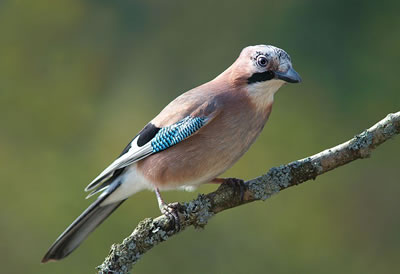Eurasian Jay

Facts about creatures
- Home
- Animal Classification
- Animal Habitats
- Amphibians
- Arthropods
- Bats
- Birds
- Carnivorans
- Cetaceans
- Chordates
- Crustaceans
- Dinosaurs
- Diprotodonts
- Elephants
- Fish
- Golden Mole
- Insects
- Lagomorphs
- Mammals
- Mammal Teeth
- Marsupial Mole
- Metamorphosis
- Mollusks
- Primates
- Reptiles
- Rodents
- Ruminants
- Soricomorphans
- Tenrec
- Tetrapods
- Vertebrates
Eurasian Jay
The Eurasian jay is a member of the crow family.
It is a passerine.
It is found in western Europe, eastern Asia and northwest Africa.
Acorns are its main food, and it prefers to live in oak forests.
The Eurasian Jay has an excellent memory, which enables it to hoard and retrieve acorns, allowing it to survive in times of scarcity.

Its body is mostly pinkish brown. Its wings are black and gray with a white patch and its wing coverts (the outer layer of feathers, which reduce air resistance) have pale blue and black bars.
It has blue eyes and a wide black streak that looks like a mustache.
The Eurasian jay has a crest, with black and white spots, on its forehead. It raises this crest during mating displays.
Its main call is a loud, rasping shriek.
Acorn Hoarding
The Eurasian jay’s diet mostly consists of acorns.
In September and October, Eurasian jays look for acorns beneath oak trees.
They store the acorns that they do not eat, ensuring that they will have food for the whole year.
The Eurasian jay has an unusually large esophagus, which can hold up to nine acorns at a time.
Usually, a jay will pick up three or four acorns at once, and then take each acorn to a separate hiding place, which could be under leaves, among moss, or in a small hole. Sometimes, the jay will use its own beak to dig a hole in the ground
The hiding place is usually within half a mile of where the acorn was found, but it could be as much as two miles away.
Eurasian jays remember exactly where they have hid their acorns.
They know just where to find them under snow-covered ground.
If there is a surplus of acorns, some of the acorns that are not retrieved by the jays grow into new oak trees.
The Eurasian jay’s method of hoarding acorns is probably the most important means by which oaks spread uphill.
A jay usually eats an acorn by using its toes to hold it against a branch or on the ground. It uses its slightly hooked beak to tear off the shell, so that it can eat the core.
Courtship and Breeding
Large gatherings of up to thirty Eurasian jays, all seeking mates, come together in the spring.
At these gatherings, the birds call and display excitedly.
Jays prefer to build low nests, in thick undergrowth. They build nests in bushes and small trees, in evergreens such as ivy, or in suckers next to a tree trunk.
Sometimes they will nest in the outer branches of a large tree.
Both male and female help to build the well-concealed nest.
They use soil and many small sticks and twigs. The nest is lined with a thick layer of fine roots.
The female usually lays four to six eggs at the end of April or in May. It is usually the female who sits on the nest. She only leaves when the male comes to feed her and guard the nest.
The eggs hatch after 16 days but the female sits on the nest for about another week.
The male feeds the chicks during this time.
Parents feed the chicks caterpillars from nearby bushes and trees. The parents store the caterpillars in their throats and then carefully place them in the chicks’ mouths.
Young Eurasian jays stay in the next for about three weeks, but do not become fully independent for another two months.
Therefore, Eurasian jays only raise one brood each year.